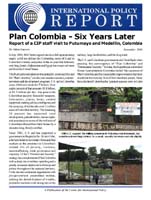« Not quite an arms race, but still troubling | Main | On the road again... »
October 31, 2006
New CIP report: "Plan Colombia - Six Years Later"
 We have just released a new twenty-page "International Policy Report" on Colombia.
We have just released a new twenty-page "International Policy Report" on Colombia.
Plan Colombia - Six Years Later (1.3MB PDF file) gives a look at conditions in Putumayo and Medellín, Colombia, as we saw them last July, six years almost to the date after President Clinton signed into law the first "Plan Colombia" aid package.
Regular visitors to this weblog may recognize some of the report's pictures and prose. Four different blog entries in July and August served more or less as "beta versions" for this final product.
Here is the text of the release summarizing and announcing the new report.
October 31, 2006
Plan Colombia - Six Years Later: The Center for International Policy releases a new report on Putumayo and Medellín, Colombia
In July 2000, President Clinton signed into law a big aid package called "Plan Colombia," with the ambitious goal of helping Colombia to resolve its related problems of drug trafficking and violence. Since then, the United States has given Colombia $4.7 billion. No other country outside the Middle East comes close. Of that aid, 4 out of every 5 dollars - $1.5 million per day - has gone to Colombia's police and military.
Since 2002, meanwhile, Colombia's government has been led by a president, Álvaro Uribe, whose governance strategy - called "Democratic Security" - heavily favors military force.
Has this combination of two largely military strategies worked? After so much investment in weapons and offensives, is the country more secure, better governed, and out from under the illegal drug economy?
No, mostly not, finds Plan Colombia - Six Years Later, a new report from the Center for International Policy.
In July, exactly six years after Plan Colombia's inception, CIP Colombia Program Director Adam Isacson visited Putumayo, the southern jungle department where U.S.-funded Plan Colombia operations began. He also went to Medellín, Colombia's second-largest city which, due to its sharply reduced rates of violence, is often viewed as a showcase of the Uribe government's U.S.-backed security policies.
In Putumayo, where the United States has invested hundreds of millions, CIP found that conditions had improved only slightly. While massacres are less frequent and road travel is easier, guerrillas remain strong and active in the countryside, and supposedly demobilized paramilitaries continue to dominate the main towns. Cultivation of coca, which was reduced by an initial blitz of fumigation, is rebounding as the spray planes have followed the plant elsewhere in Colombia. And alternative-development programs have yielded mostly disappointing results. Putumayo, where Plan Colombia began, is still in crisis, and distrust of the Colombian government remains very strong.
In Medellín, the "miracle" of declining crime rates owes only partially to Uribe's "Democratic Security" strategy. Increased military and police presence have made some difference, but two other factors have been at least as important.
First, "the paramilitaries won." Though officially demobilized, local paramilitary leader "Don Berna" and his men now control much of Medellín's organized crime. Their dominion over the city's vast, historically conflictive slums is no longer disputed with guerrilla militias or other criminal gangs. As a result, they are killing far fewer people.
Second, Medellín's city government is investing its own resources in poor neighborhoods' governance, and in the reintegration of former rank-and-file paramilitary fighters and gang members. Medellín's government has filled much of the vacuum left by the central government's lack of a well-thought-out, well-financed strategy for assisting former combatants. In most Colombian cities and towns, though, this vacuum remains in place, leaving few options for thousands of unemployed men whose main skill is killing.
With twenty pages of narrative, graphics and photos, Plan Colombia - Six Years Later offers a rare, unvarnished view of conditions "on the ground" in Colombia and the impact of the United States' high-profile, high-cost strategy. The report is available free of charge, as a PDF file in English, at http://www.ciponline.org/colombia/0611ipr.pdf.
Posted by isacson at October 31, 2006 12:43 PM
Comments
I've only done an extremely quick read through the report as I type this, but for the most part, yes, much of the material seems familiar.
Familiar, yes, but still well documented and, ultimately, I'm mostly in agreement with the descriptions conclusions presented.
The difference is that I'm slightly to somewhat more positive about the security situation despite its limitations, admittedly and especially regarding the areas outside the report's scope (Putumayo being one of the most fragile), though I fully agree about the complete ineffectiveness of current drug war policies and the flaws that persist in a strategy with a heavy militaristic slant.
Posted by: jcg ![[TypeKey Profile Page]](http://www.ciponline.org/colombia/blog/nav-commenters.gif) at October 31, 2006 4:54 PM
at October 31, 2006 4:54 PM
I hope to have time this weekend to read through the CIP report. Of course, if I'm too tired to read, I can always play the video "Plan Colombia," a Link TV program I recorded this summer. It even has a (brief) interview with our own Adam Isacson. I suspect the video is more "leftist" and less-balanced than the CIP report. However, it is nice to see Adam on the TV screen.
Posted by: richtiger ![[TypeKey Profile Page]](http://www.ciponline.org/colombia/blog/nav-commenters.gif) at October 31, 2006 11:56 PM
at October 31, 2006 11:56 PM
Post a comment
Thanks for signing in, . Now you can comment. (sign out)
(If you haven't left a comment here before, you may need to be approved by the site owner before your comment will appear. Until then, it won't appear on the entry. Thanks for waiting.)